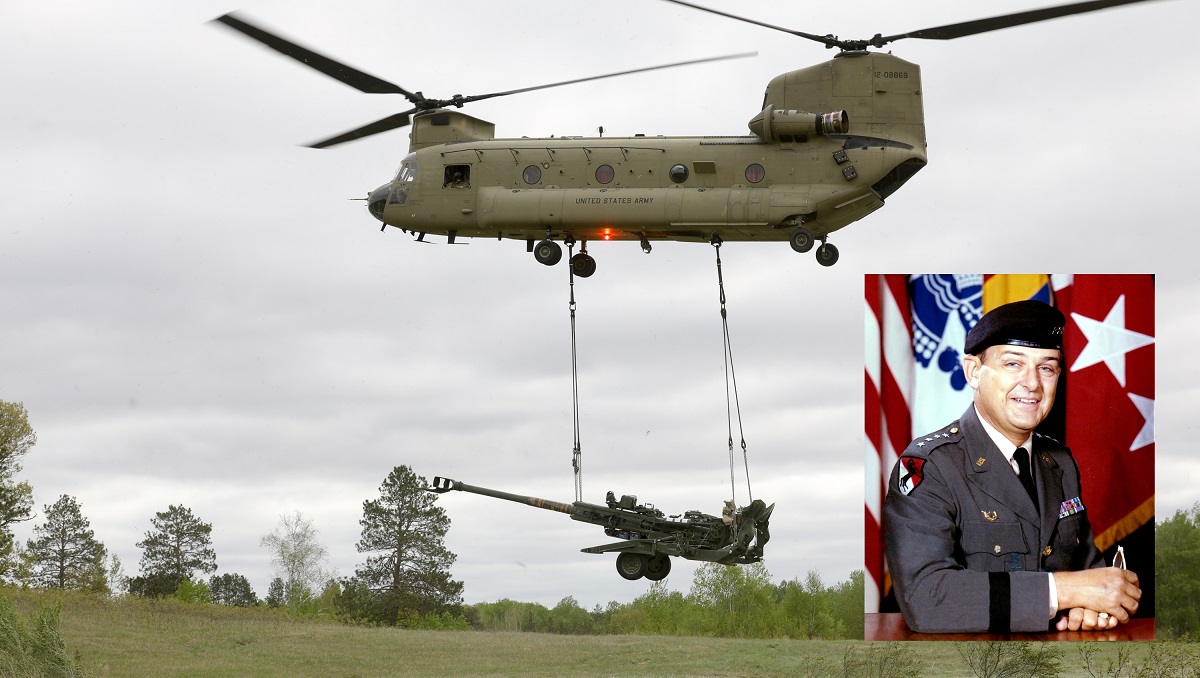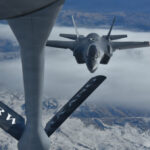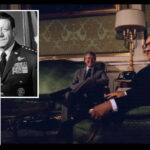
Starry’s work initiated an intellectual renaissance in twentieth-century military thought, which can still serve as a model for the army (and other services) as they develop operational concepts, weigh the trade-offs associated with modernization, and more generally seek to understand how wars will be fought on the twenty-first-century battlefield.
Today, U.S. Army General Donn A. Starry, the commanding general of the U.S. Army’s Training and Doctrine Command (TRADOC) from July 1977 to July 1981, is best remembered as the architect of the Cold War doctrine known as AirLand Battle, that first appeared in the 1982 edition of Army Field Manual (FM) 100-5, Operations. AirLand Battle doctrine was an artifact of a dispirited army turning its attention away from recent failed counterinsurgency operations in Vietnam to focus instead on the Warsaw Pact and the defense of Western Europe. Starry’s work initiated an intellectual renaissance in twentieth-century military thought, which can still serve as a model for the army (and other services) as they develop operational concepts, weigh the trade-offs associated with modernization, and more generally seek to understand how wars will be fought on the twenty-first-century battlefield.
Starry developed AirLand Battle to replace the controversial doctrine of Active Defense that his predecessor and inaugural TRADOC commander, General William DePuy, had developed for the 1976 version of FM 100-5. Many U.S. Army officers and defense analysts rejected DePuy’s approach, deeming Active Defense as reactive, emphasizing defense and stopping the “Soviet operational breakthrough maneuver” rather than taking the offensive. But affecting change in an institution as large as the army is challenging. As retired brigadier general Huba Wass de Czege has pointed out, “the Army’s struggle to get the doctrine ‘right enough’ after Vietnam” took “13 years”, and when AirLand Battle was “right enough,” it was a “way of thinking about war and a mental conditioning rather than a rigid set of rules and list to be done in lock-step fashion.”
Starry had as commanding general of the U.S. Army Armor Center and School under DePuy played a prominent role in fashioning Active Defense through his analysis of the 1973 Arab-Israeli (Yom Kippur) War and other activities. However, in his follow-on assignment as commander, V Corps in West Germany from 1976 to 1977, he began a rigorous effort to determine if employment of Active Defense was realistic. Using terrain analysis, experiments, examination of Soviet military doctrine, and information about force ratios, Starry concluded U.S. Army units in the V Corps sector of NATO’s central region would be considerably outnumbered. This assessment along with a reexamination of his earlier study of the Yom Kippur War, whereby he modified the tactical lessons of that conflict to the NATO scenario, prepared Starry for his next assignment as TRADOC commander. He was primed to revise the Active Defense doctrine.
As important as AirLand Battle doctrine was, however, it was only one element of a more complex conceptualization of warfare based on the idea of the “central battle,” which Starry defined as “the place on the battlefield where all aspects of firepower and maneuver come together to produce decisive action.” As he noted, “When the Central Battle idea was first conceived, I made the point that operational concepts had to be the driving force for describing interactions that were to occur on the most intense part of the battlefield (emphasis added).” Operational concepts do not validate the procurement of a specific weapon system or equipment. They are ideas necessary to achieve a desired military objective, but must be adaptable to changing perceptions and circumstances. Further, he stressed that they must be tested and their relationship to other concepts—tactical, organizational, training, and materiel concepts—ascertained. He was clear: “Concepts are not (emphasis in the original) doctrine until tested, approved, and accepted.” Thus, Starry fashioned a framework for how concepts not only resulted in doctrine, but the relationship doctrine had to training development, materiel requirements and organizations.
The first component he stipulated for framing an operational concept was the threat. To help define threats, Starry—unimpressed with how the former Army Combat Development Command had used long-range forecasts to determine requirements for the future combat environment—called for the army to work with the intelligence community to develop estimates of enemy capabilities. After discussions with the intelligence professionals, Starry came to believe that eight years was the appropriate time horizon for threat estimates informing combat developments; thus, 1986 became the endpoint for a number of studies that TRADOC conducted. However, Starry was also aware that the threat often changes, with the enemy devising countermeasures that complicate doctrine’s formation and narrowing its useful life.
The second component to framing an operational concept was defining the mission that the theater commander confronts at the operational level of war. Starry and others believed that the army had neglected to do this when formulating Active Defense. Starry stated simply that the mission was to fight and win at that level. In the European context, U.S. vital interests were at stake; therefore, the mission at the operational level was to “disrupt, delay, and destroy as possible” the attacking and follow-on Warsaw Pact forces, and “to win, not just avert defeat.” Starry envisioned NATO forces using a combination of deep attack and close-in battle to seize and hold the initiative through maneuver and fires. The use of such conventional means raised the nuclear threshold. Nonetheless, the army had to be capable of operating on the nuclear battlefield, because the Soviets were prepared to use these weapons.
When developing AirLand Battle, Starry was actually more interested in emerging deep fires and surveillance capabilities, systems that would help target and destroy enemy assets in the extended battlefield, and make deep attack possible.
The third component of developing an operational concept was the opportunities that new technology offered. Technological developments drive war, Starry noted, but “technology wins nothing unless it serves some doctrinal purpose.” It is worth noting that even before Active Defense, the army had already begun the modernization effort that would lead to the fielding of the “Big 5” systems (AH-64 Apache attack helicopter, the M-1 Abrams main battle tank, the UH-60 Black Hawk utility and transport helicopter, the Bradley fighting vehicles, and the Patriot air defense missile system). When developing AirLand Battle, Starry was actually more interested in emerging deep fires and surveillance capabilities, systems that would help target and destroy enemy assets in the extended battlefield, and make deep attack possible. The Army Tactical Missile System (ATACMS) that was in development met the second requirement. Working with the Air Force’s Tactical Air Command, Starry recognized that Joint STARS, the U.S. Air Force’s airborne battle management, command and control, intelligence, surveillance and reconnaissance platform, was the answer to the first. The emphasis was on the integration of U.S. air and ground forces, and ultimately, U.S. forces with those of our allies.
The final component was historical insight, or as Starry once wrote, “The acquisition of a sense of historical mindedness.” Starry—an avid student of U.S., British, Soviet, and German tactics and operations in World War II, as well as of theoreticians like Jomini and Clausewitz—believed that studying military history helped officers develop professional technical competence. History was not a blueprint, he maintained, but a means of improving judgment and fashioning a logical approach to problem solving and to understanding the “reasons for and the results of previous solutions.” But the value of historical insights went beyond reading traditional history texts; it included analysis and studies of doctrine, policy, planning exercises, campaigns and individual battles to learn especially under what circumstances outnumbered forces won battles and campaigns. These assessments were critical to understanding NATO’s defense against a massive Warsaw Pact attack into West Germany. Systemizing these insights was critical; thus, historical knowledge undergirded the 1982 edition of FM 100-5.
In Starry’s framework, TRADOC was responsible for integrating these four components into a draft concept statement of a page or two, which when approved, resulted in a concept paper that was a comprehensive analysis of the requirement and the preferred outcome, the concept of how this end was to accomplished, where and when it needed to be undertaken, the organization that is was responsible for doing it, and what was needed for achieving the desired result that addressed tactics, equipment, organizations, and training. A lengthy and thorough evaluation process, which Starry stated was the “business of TRADOC,” followed the approved concept paper and only then, after discussions within the Army and with other services and allies, was an operational concept incorporated into doctrine, training developments, materiel requirements, and organizations.
Starry’s approach, however, is not an input-output model. It is a framework that forces senior military leaders to undertake a methodical planning process that produces a theory of victory for both conventional and nuclear battlefields, grounded in U.S. policy objectives and its national defense strategy, before the army makes any substantial investment. Observers seem to think that the Ukraine and Gaza conflicts are going to lead directly to a new doctrine of war in the same way that conventional wisdom believes the Yom Kippur War produced AirLand Battle doctrine. However, just as the Yom Kippur war was merely an inflection point in the post-Vietnam reassessment of operational doctrine, these two conflicts, though rich in data, will likely only be part of the story of future doctrine development. In making these early assessments of means versus way and ends, the principal focus is on the tactical level of war and finding technological solutions, with little emphasis on the operational level of war where military resources are employed to achieve the strategic objectives (e.g., deterrence and warfighting) necessary to protect U.S. interests. For those looking for ways to accomplish strategic objectives, Starry’s framework and the evolution of AirLand Battle doctrine provide a useful guide.
Frank Jones is a Distinguished Fellow of the U.S. Army War College where he taught in the Department of National Security and Strategy. Previously, he had retired from the Office of the Secretary of Defense as a senior executive. He is the author or editor of three books and numerous articles on U.S. national security.
The views expressed in this article are those of the author and do not necessarily reflect those of the U.S. Army War College, the U.S. Army, or the Department of Defense.
Photo Description: Soldiers from the 1-194th Field Artillery complete joint slingload training with UH-47 Chinook Helicopters out of the 2-211th General Support Aviation Battalion at Camp Ripley Training Center on May 19th, 2023. The two units worked together to complete two iterations of slingloading and firing two M777 Howitzers. Inset: GEN Donn A. Starry as Commander in Chief, U.S. Readiness Command
Photo Credit: Spc. Jorden Newbanks Inset: U.S. Readiness Command, Public Domain, via Wikimedia





General Donn Starry was an absolute visionary. Multidomain Operations, conceptually and at its core, is simply Starry’s principle of extended battlefields. “What emerges is a perception of the battlefield in which the goal of collapsing the enemy’s ability to fight drives us to unified employment of a wide range of systems and organizations on a battlefield which, for corps and divisions, is much deeper than that foreseen by current doctrine. ” Getting the Army of 2040 force structure, training pipeline, and organizational shape, at echelon, correct will be necessary to harness a growing reliance on information warfare, management of the electromagnetic spectrum, cyberspace, and AI-enabled systems.
General Starry spoke multiple times to the new Joint Advanced Warfighting School in Norfolk near the end of his life. He was a man of great learning having a massive collection of books on a wide range of subjects, many in foreign languages which he had mastered. As many know, GEN Abrams tapped him to begin helping reshape the Army in the immediate post-Vietnam period. He did so in ways that were truly inspiring and very self depricating as he always credited his staff with the development and spreading the gospel of what became AirLand Battle. He also credited his positive relationship with the USAF’s Tactical Air Command on the 31 Initiatives which were concrete expressions of how the two Services would work together to achieve the doctrine’s success. Many have credited our success in Desert Storm to Gen Starry’s efforts. He remained humble of his role as he spoke to the JAWS students, preferring to discuss his views on leadership of change in the military vice the history of how AirLand Battle came about so I would agree that he was more focused on how to implement change in the military vice the specifics of what changes were needed. As others have said, the specifics of warfighting do change over time but the true battles are fought in the minds of those who are responsible for preparing for and engaging in war.
I was more an ‘errand boy for Col Don Holder and Huba Wass de Czege at CGSC, but as an FA major on the CGSC faculty, I helped them translate Gen Stary’s handwritten notes on drafts and added some fire support experience.
During the “Cold War” I commanded an 8-inch FA battalion and as us RVN vets like to say “at least we won the Cold War”
Holder and Wass de Czege visited the AWC many times during my faculty time (1993-97) imparting their experience to our combat developers.
From the final paragraph of our article above:
“Starry’s approach, however, is not an input-output model. It is a framework that forces senior military leaders to undertake a methodical planning process that produces a theory of victory for both conventional and nuclear battlefields, grounded in U.S. policy objectives and its national defense strategy, before the army makes any substantial investment. Observers seem to think that the Ukraine and Gaza conflicts are going to lead directly to a new doctrine of war in the same way that conventional wisdom believes the Yom Kippur War produced AirLand Battle doctrine. However, just as the Yom Kippur war was merely an inflection point in the post-Vietnam reassessment of operational doctrine, these two conflicts, though rich in data, will likely only be part of the story of future doctrine development. In making these early assessments of means versus way and ends, the principal focus is on the tactical level of war and finding technological solutions, with little emphasis on the operational level of war where military resources are employed to achieve the strategic objectives (e.g., deterrence and warfighting) necessary to protect U.S. interests. … ”
Re: the two wars (the Ukrainian and the Gazan) noted in the first sentence of the quoted item above,
a. If today’s Ukraine conflict can (properly?) be viewed (however advertised by Putin) as being Russia’s attempt to “contain” and/or to “roll back” the efforts being made by the U.S./the West to transform Russia (via Russia’s exposure to Ukraine) more along contemporary western political, economic, social and/or value lines (to wit; our approach and our political objective):
“So Putin’s war is a consequence of his fear that Russia as it is today will inevitably slip from his grasp and that more democratic-leaning leaders there, not just those in Ukraine, will one day petition to become members of NATO and that it will become a state of consent. If the West can protect Ukraine — with advanced anti-ship, anti-aircraft, and other defensive weapons, with a sustained airlift and land convoy of food and medicines, with global economic ostracism of Putin’s regime — that day will come. (See the March 24, 2022 “Just Security” article “Putin’s Real Fear: Ukraine’s Constitutional Order.”)
b. And if today’s Gazan (etc.) conflict(s), likewise, can (properly?) be viewed (however depicted by Iran) as being Iran, et. al’s, attempt to “contain” and/or to “roll back” the efforts being made by the by the U.S./the West to transform the Middle East (via the Middle East’s exposure to Israel) more along contemporary western political, economic, social and/or value lines (to wit: again, our approach and our political objective),
Then might GEN Starry’s ideas/his ways of thinking (with its emphasis on deterring/winning conventional and nuclear war — and, this, in relation to and in support of the U.S./the West “containment” and “roll back” strategies back in the Old Cold War?); can these such ideas and ways of thinking — also, likewise and/or similarly — be used in relation to and in support of the contemporary U.S./Western strategy, and this strategies related approaches, such as those that I have suggested at my items “a” and “b” above? (And if so, how might this be?)
(I hope these are good questions.)
Error: The Ukrainian and Gazan conflicts are addressed in the THIRD paragraph of my first quoted item above. Apologies.
I am having a very bad day. The Ukrainian and Gazan conflicts are addressed in the third sentence (not the third paragraph) of my first quoted item above. Sorry.
In my opinion, our US Armed Forces must stop much magical thinking and giving in to Woke politicians in matters of recruitment, education and training. After all, MIT is reinstating the SAT and ACT tests.
We are reinstating our SAT/ACT requirement for future admissions cycles by Stu Schmill ’86
https://mitadmissions.org/blogs/entry/we-are-reinstating-our-sat-act-requirement-for-future-admissions-cycles/
A needless DOD expense is the Office for Diversity, Equity, and Inclusion Department of Defense
https://diversity.defense.gov/
We don’t have proof that DEI improves performance or delivers superior performance. On the face, many of the concepts of DEI rest on logical fallacies. The logic escapes me of how we can build a superior force if we make sub-optimal choices in recruitment. The People’s Republic of China (PRC)has more people than we do, thus we have fewer people and those fewer people have to out think the PRC since they can throw more bodies at a problem.
We have these resources which cast doubt on the benefits of multiculturalism, DEI, etc. Also, they cast doubt on the moral values of other cultures.
‘The Culture Transplant’ Review: Immigration’s Legacy
https://www.wsj.com/articles/the-culture-transplant-review-immigrations-legacy-11670794152
Critical Race Theory in Six Logical Fallacies by Douglas Groothuis
https://www.nas.org/academic-questions/35/2/critical-race-theory-in-six-logical-fallacies
The Lived Experience Fallacy by Timothy Hsiao
https://www.nas.org/academic-questions/35/2/the-lived-experience-fallacy
Extraordinary Popular Delusions and the Madness of Crowds by Charles Mackay
Napier’s Lesson
http://esr.ibiblio.org/?p=4451
We have a better understanding of diversity of thought and how that would improve both our society and our Armed Forces, but that is not what the Office of Diversity, Equity and Inclusion mission is. Unfortunately, we could end up looking like the Austria Hungarian Empire which came apart. The resources that cast doubt on DEI are as follows:
The Difference: How the Power of Diversity Creates Better Groups, Firms, Schools, and Societies by Scott Page Pages 37 – 39
Part III: Diverse Values: A Conflict of Interests (Or Is It?)
Up to this point, the results should bring joy and happiness. We might all think diversity is a wonderful thing. That’s because we’ve ignored diverse preferences, differences in what we value. Preference diversity differs from toolbox diversity: Toolbox differences do not create conflict. Preference diversity can and does. For this reason, management books stress agreeing on a common goal—a common fundamental preference. If people disagree about what they’re trying to accomplish, they function poorly as a collective.
Common fundamental preferences need not imply agreement. People can also have diverse instrumental preferences. They can differ on how they think it best to cross a particular finish line. In other words, people can disagree over means as well as ends. Instrumental preferences are preferences about means, so they implicitly contain predictive models. We like (or don’t like) a policy of a higher minimum wage because we think it helps (hurts) workers. This distinction between fundamental and instrumental allows two people to agree over the destination—a romantic dinner at Charlie Trotter’s restaurant in Chicago—but to disagree over how to get there—cab or train.9
My treatment of the potential problems created by preference diversity is at best a flyover of the relevant results—“Look, there’s the Grand Canyon.” The first result, Arrow’s Theorem, gives conditions under which individual preferences do not aggregate into a collective preference. The second result, proved by Charles Plott, states that with majority rule voting, any proposed alternative can be defeated by some other alternative. The third result, proved by Richard McKelvey and Norman Schofield, states that if people vote sincerely, then a sequence of majority rule choices could lead anywhere. We could even have action figure governors! The final result, proved simultaneously by Mark Satterthwaite, an economist, and Allan Gibbard, a philosopher, states that people have incentives to misrepresent their preferences.
These four results paint a bleak picture only if we believe preference differences to be fundamental. In many organizations and communities, members all pull for the same goal. What preference diversity does exist is instrumental. If so, I’ll argue that the negative results aren’t so bad after all.
I complete this third part of the book with a brief analysis of how toolbox and preference diversity interact. In doing so, I turn some of the intuitions from the previous chapters on their heads. Diverse perspectives, which we touted as a panacea, have a dark side—they lead to the discovery of lots of possible alternatives. If people have diverse fundamental preferences, they less likely agree when they have more possible choices. On the flip side, diverse fundamental preferences, which cause so many problems when making choices, prove beneficial for problem solving. What we desire influences how we look at problems, the perspectives we choose. Thus, collections of people with diverse preferences often prove better at problem solving than collections of people who agree. Difference of opinion not only makes a horse race, it also makes for effective, albeit sometimes contentious, teams.10
Diversity and Its Limits
The crisis of American democracy demands a clear-eyed understanding of the ways in which differences in ethnic groups and some sources of political polarization are never going to be resolved. by Charles Murray
https://claremontreviewofbooks.com/diversity-and-its-limits/
Ethnic Diversity and Social Trust: A Narrative and Meta-Analytical Review
Annual Review of Political Science
Vol. 23:441-465 (Volume publication date May 2020)
First published as a Review in Advance on March 9, 2020
https://doi.org/10.1146/annurev-polisci-052918-020708
https://www.annualreviews.org/doi/abs/10.1146/annurev-polisci-052918-020708
One of the questions, has the US Army readied itself to understand what a new framework means and to work and to fight under the new conditions? This was not entirely the case in World War I.
The AEF Way of War: The American Army and Combat in World War I by Mark Ethan Grotelueschen
How the Drone War in Ukraine Is Transforming Conflict
Drone technology has been used extensively in twenty-first-century armed conflict, but the Russia-Ukraine war is driving innovations in autonomous warfare not seen on other battlefields. Article by Kristen D. Thompson January 16, 2024 2:12 pm (EST)
https://www.cfr.org/article/how-drone-war-ukraine-transforming-conflict
Some think with AI, we are in a new industrial revolution. Are we able to reach out to civilian firms to understand how to adapt their ideas into new weapons systems. For instance, has John Deere come up with AI that could be adapted?
Precision Ag Technology
https://www.deere.com/en/technology-products/precision-ag-technology/
Do we have our former unity that we saw in WWII today? What about?
Ensign Gay
Earnest’s wounded radioman/gunner, Airman Third Class Harry Ferrier, also survived. But 45 of the 48 men of VT-8 were killed that day.
https://www.usni.org/magazines/naval-history-magazine/2017/june/torpedo-eights-celebrated-survivor
Finally, in my opinion, we need politicians, leaders, universities, colleges and most importantly churches to rebuild our social capital and common understanding of religion and morality. Only then, will we truly be a United States of America.
This Fine contribution to War Strategy must be streamlining with the current frontline and ground requiremements for a Model of Preventive-Offensive-Advanced-Deep-Broad and Long Security-Defence-War (POADBL / SDW). The Preventive Module will be backed by Reliable and Rapid Information and Communication Systems (RICS).
From hot or violent conflicts of interests, you and true responsibles will be engaged in articulating convergence of interests by sharing common benefits, societal values. In doing so, you, actors and groups will avoid breaking reciprocal rights and duties, for and by people.